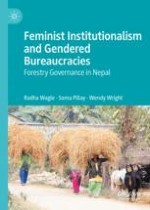2020 | OriginalPaper | Buchkapitel
3. The History of Nepalese Forest Management and the Roles of Women
verfasst von : Radha Wagle, Soma Pillay, Wendy Wright
Erschienen in: Feminist Institutionalism and Gendered Bureaucracies
Verlag: Springer Singapore
Aktivieren Sie unsere intelligente Suche, um passende Fachinhalte oder Patente zu finden.
Wählen Sie Textabschnitte aus um mit Künstlicher Intelligenz passenden Patente zu finden. powered by
Markieren Sie Textabschnitte, um KI-gestützt weitere passende Inhalte zu finden. powered by
